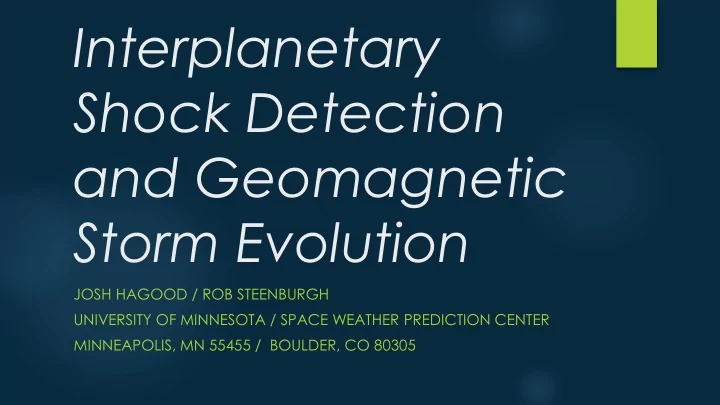

Interplanetary Shock Detection and Geomagnetic Storm Evolution JOSH HAGOOD / ROB STEENBURGH UNIVERSITY OF MINNESOTA / SPACE WEATHER PREDICTION CENTER MINNEAPOLIS, MN 55455 / BOULDER, CO 80305
Goal Increase accuracy of 3 hourly K P forecast Important for: warning power companies, airlines… etc Spacecraft operations (tracking, drag, orientation)
Introduction ► Primary focus on CMEs and K-index ► Shock detection at ACE ► Time from detection to G-scale thresholds
K-Index Two types: K b and K P
G-Scale
Methods 2 Shock tables: Cash - manually compiled Smith (Vorotnikov) – automated shock detection algorithm K-based alerts from SWPC Elapsed time using Octave Limited to 24 hours
Assumptions/Considerations No distinction between K b or K p Origin of shocks is undetermined Post-March 2002 Limits “Old”: K=5: 10h K=6: 15h K=7-9: 24h “New”: K=5-9: 24h
Results Smith Tables Old New Elapsed Time from Shock to Kp Level (hours) using Smith et.al. Elapsed Time from Shock to Kp Level (hours) using Smith et.al. Kb and Kp: 03/2002-12/2014 Kb and Kp: 03/2002-12/2014 Standard Standard K-Index Mean Median Minimum Maximum Deviation Number of Cases K-Index Mean Median Minimum Maximum Deviation Number of Cases 5 3 2 0 9 2 53 5 7 5 0 23 7 78 6 4 3 0 14 3 42 6 7 5 0 23 7 54 7 6 4 0 23 6 20 7 6 4 0 23 6 20 8 6 5 1 13 4 9 8 6 5 1 13 4 9 9 5 6 2 6 0 3 9 5 6 2 6 2 3 Kb: 03/2002-12/2011 Kb: 03/2002-12/2011 Standard Standard K-Index Mean Median Minimum Maximum Deviation Number of Cases K-Index Mean Median Minimum Maximum Deviation Number of Cases 5 3 3 0 9 2 49 5 7 5 0 23 7 71 6 4 3 0 13 3 38 6 7 5 0 23 7 49 7 6 4 0 23 6 18 7 6 4 0 23 6 18 8 6 6 1 13 4 8 8 6 6 1 13 4 8 9 5 6 2 6 2 3 9 5 6 2 6 2 3 Kp: Post 12/2011 Kp: Post 12/2011 Standard Standard K-Index Mean Median Minimum Maximum Deviation Number of Cases K-Index Mean Median Minimum Maximum Deviation Number of Cases 5 2 2 0 6 2 4 5 7 4 0 17 7 6 6 5 3 2 14 5 4 6 8 3 2 17 6 5 7 6 6 4 7 1 2 7 6 6 4 7 1 2 8 N/A N/A N/A N/A N/A 0 8 N/A N/A N/A N/A N/A 0 9 N/A N/A N/A N/A N/A 0 9 N/A N/A N/A N/A N/A 0
Smith Histograms: Post-2002 Old New Cash Histograms: Post-2002 New Old
Smith Boxplots: Post-2002 Old New
Cash Boxplots: Post-2002 Old New
April 13, 2006 at 11:12
Smith CDF Plots: Post-2002 Old New
Cash CDF Plots: Post-2002 Old New
Conclusions K b and K p are similar Shorter times more likely Median times from 2 to 6 hours Possible coronal holes in expanded data set Next Steps: Separate CMEs from coronal holes Evaluate individually
References and Acknowledgements Cash, M. D., J. S. Wrobel, K. C. Cosentino, and A. A. Reinard (2014), Characterizing interplanetary shocks for development and optimization of an automated solar wind shock detection algorithm, J. Geophys. Res. Space Physics, 119, 4210 – 4222, doi:10.1002/2014JA019800. Vorotnikov, V. S., C. W. Smith, Q. Hu, A. Szabo, R. M. Skoug, and C. M. S. Cohen (2008), Automated shock detection and analysis algorithm for space weather application, Space Weather, 6, S03002, doi:10.1029/2007SW000358. This work was supported by the NSF REU grant 1157020 to the University of Colorado.
Recommend
More recommend